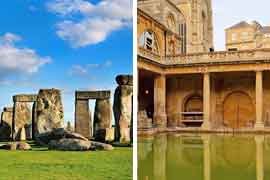The Roman Baths
A Comprehensive Guide for Travellers Visiting the Roman Baths, the Ancient Public Bath in Bath, England
The Roman Baths in Bath, England, are a must-visit for history enthusiasts and curious travellers alike. Located about 115 miles west of London, this remarkable site dates back nearly 2,000 years and stands as one of the best-preserved ancient Roman sites in the world.
Visitors can explore stunning Roman architecture, learn about historical bathing rituals, and marvel at a collection of fascinating artefacts.
For travellers, the Roman Baths offer more than just a glimpse into the past; they provide an immersive experience that vividly brings history to life. This guide will help you plan your visit, covering how to get there, what to see, ticket information, and tips to make the most of your trip.
Essential Visitor Information for Roman Baths
Getting There
Address: Abbey Church Yard, Bath, BA1 1LZ
Train: Direct trains from London Paddington to Bath Spa station.
Bus: National Express and Megabus services from London’s Victoria Coach Station.
Car: Approx. 2.5 hour drive from London via M4 motorway.
Opening Times
The Roman Baths is open every day except Christmas Day and Boxing Day (25-26 December).
Winter: 10am-6pm (open at 9am at weekends)
Summer: 9am-10pm
Last admission is 1h before closing time.
Tickets & Prices
Time Needed to Visit
A visit to the Roman Baths generally takes between 1.5 and 2 hours.
Accessibility
The Roman Baths are committed to providing an inclusive experience for all visitors. While some areas may have limited access due to their ancient structure, the Baths endeavour to accommodate everyone with alternative routes and facilities.
- Facilities for Disabled Visitors: The site is wheelchair accessible, with lifts and ramps available throughout the complex. Wheelchairs can also be borrowed free of charge from the reception desk.
- Companion Tickets: Free tickets are available for carers or companions, which can be arranged at the time of ticket purchase.
- Special Tours and Services: Audio guides and tactile displays cater to visitors with visual or hearing impairments. Special tours designed for disabled visitors can be arranged in advance.
- Support for Various Needs: The Roman Baths offer support for neurodiverse visitors, visitors with dementia, hearing impairments, claustrophobia, visual impairments, and wheelchair access.
For the most accurate and detailed information regarding accessibility, visitors are encouraged to consult the official Accessibility at Roman Baths website.
Family Friendly
Is The Roman Baths Family Friendly?
Yes, the Roman Baths in Bath, England, are family-friendly. They offer various activities and resources tailored for families and children, including:
- Interactive Exhibits: Engaging displays and hands-on activities help children learn about the history of the baths in a fun way.
- Family Trails: These self-guided tours are designed to keep kids entertained while exploring the site.
- Audio Guides: Special audio guides are available for children, making the experience more accessible and enjoyable for younger visitors.
- Children’s Events: Throughout the year, the Roman Baths host events and workshops specifically for families and children.
Overall, the Roman Baths make an effort to ensure that families have an enjoyable and educational visit.
Getting to the Roman Baths
Travellers can choose from several convenient options to reach the Roman Baths from London.
Address of the Roman Baths
The Roman Baths are located at Abbey Church Yard, Bath, BA1 1LZ. Bath is well-connected by public transport, making it easily accessible from various locations, including London.
|
Option
|
Average Price
|
Time
|
Details
|
|---|---|---|---|
|
£30
|
1.5 h
|
Direct trains available from London Paddington to Bath Spa Station.
|
|
|
£15
|
3-4 h
|
Services operated by National Express and Megabus, departing from various locations in London, including Victoria Coach Station.
|
|
|
£25 (fuel)
|
2.5 h
|
Route via the M4 motorway westbound, exiting at Junction 18 and following the A46 into Bath. Many hotels in Bath offer their own parking facilities.
|
|
Train Travel
Travelling by train is one of the fastest and most convenient ways to reach Bath from London, apart from the tours.

Which train station should I use to travel from London to Bath?
You should use London Paddington Station. Paddington Station offers direct trains to Bath and is well-connected to other parts of London via the Underground, making it accessible for most travellers.
How long does it take to travel from London Paddington to Bath Spa Station, and how frequent are the trains?
Trains from London Paddington to Bath Spa Station typically take about 1.5 hours. Great Western Railway (GWR) operates frequent services throughout the day, ensuring flexibility in travel plans.
How can I book train tickets from London to Bath, and are there any tips for getting the best rates?
Tickets can be booked online via National Rail or Trainline. It’s advisable to book tickets in advance to secure the best rates, especially during peak travel times. Advance tickets can be significantly cheaper than buying on the day.
Bus Travel
For those looking for a more economical option, travelling by bus is a viable choice.

Which bus services operate from London to Bath, and where do they depart from?
National Express and Megabus operate regular services from London to Bath. These buses depart from various locations in London, including Victoria Coach Station.
How long does the bus journey from London to Bath take, and how frequent are the services?
The bus journey takes approximately 3 to 4 hours, depending on traffic and the specific service. Buses generally run several times a day, offering flexibility for different schedules.
How can I book bus tickets from London to Bath, and are there any tips for getting the best prices?
Tickets can be booked online on the National Express and Megabus websites. Booking in advance can often secure lower prices. Additionally, look out for promotional offers and discounts.
Car Travel
Driving to Bath provides the flexibility of stopping along the way and exploring the countryside.

What is the best driving route from London to Bath, and how far is the journey?
From London, take the M4 motorway westbound towards Bath. The journey is around 115 miles. Exit the M4 at Junction 18 and follow the A46 into Bath.
How long does it typically take to drive from London to Bath?
The drive typically takes about 2.5 hours, though this can vary depending on traffic conditions.
What are the parking options in Bath, and are there any tips for finding parking?
Bath offers several parking options, including the Charlotte Street car park, which is centrally located, and the SouthGate Bath car park. Be mindful that parking in Bath can be challenging during peak tourist seasons, so arriving early is recommended.
Additionally, many hotels and accommodations in Bath offer their own parking facilities, which can be a convenient option for guests.
Visiting the Roman Baths: Opening Times
The Roman Baths are open year-round except Christmas Day (25 December) and Boxing Day (26 December), but hours can vary depending on the season.
- Regular Hours: Generally, the Roman Baths are open daily from 9:00 AM to 5:00 PM.
- Seasonal Variations: During the summer months, the baths often stay open later, sometimes until 10:00 PM. It’s best to check the official website for the most current opening hours before planning your visit.
The Roman Baths Tickets
Understanding the ticketing options can help you make the most of your visit.
- Types of Tickets: Various ticket options are available, including standard adult tickets, child tickets (ages 6-16), family tickets (for 2 adults and up to 4 children), and concession tickets for seniors and students.
- Prices and Discounts: Prices vary, with discounts available for children, seniors, students, and groups. Family tickets offer savings for groups visiting together. Additionally, purchasing tickets online in advance can sometimes include a discount.
- Where to Buy Tickets: Tickets can be purchased online on the official Roman Baths website or on-site at the entrance. It’s recommended to buy tickets online to avoid queues and ensure availability, especially during peak times. If you are going with a tour, the ticket is usually included in the tour price.
What are the ticket prices for the Roman Baths?
|
Ticket Type
|
Weekend / Bank Holiday
|
Weekday
|
|---|---|---|
|
Adult (19+)
|
£24.50
|
£21.50
|
|
Student
|
£23.50
|
£20.50
|
|
Senior (65+)
|
£23.50
|
£20.50
|
|
Child (6-18)
|
£17.00
|
£14.00
|
|
Family 2 adults + 2-4 children
|
£65.00
|
£55.00
|
|
Family 2 adults + 1 child
|
£59.00
|
£50.00
|
|
Family 1 adult + 2-4 children
|
£47.00
|
£40.00
|
What to See at the Roman Baths
The Sacred Spring
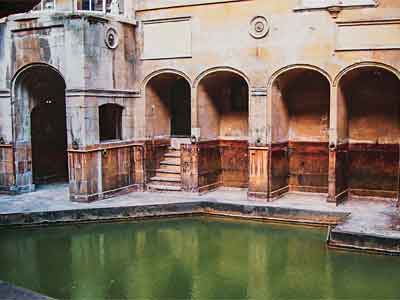
The Sacred Spring
- Importance: This natural hot spring was the focal point of the Roman Baths, believed to have healing properties. The Celts worshipped the spring before the Romans arrived, dedicating it to the goddess Sulis. The Romans later assimilated Sulis with their goddess Minerva.
- Visitor Experience: The spring still bubbles with hot water today, maintaining a temperature of 46°C (114.8°F). The sight of the steamy, mineral-rich water is captivating and connects visitors to the ancient practices of the Romans who once revered this spring.
The Roman Temple
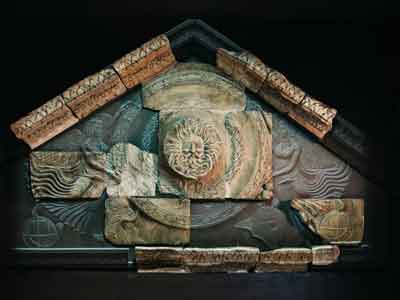
Temple pediment and the Gorgon’s Head
Image © romanbaths.co.uk
- Importance: This was the social hub of the Roman Baths, where people bathed, socialised, and conducted business. The bath house complex includes several baths of varying temperatures.
- Visitor Experience: The bath house includes the Great Bath, an impressive pool lined with lead and filled with steaming water. The intricate hypocaust system, an early form of underfloor heating, can also be seen here, showcasing Roman engineering prowess.
The Roman Bath House
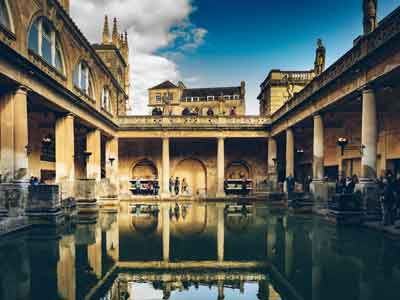
The Great Bath
- Importance: This was the social hub of the Roman Baths, where people bathed, socialised, and conducted business. The bath house complex includes several baths of varying temperatures.
- Visitor Experience: The bath house includes the Great Bath, an impressive pool lined with lead and filled with steaming water. The intricate hypocaust system, an early form of underfloor heating, can also be seen here, showcasing Roman engineering prowess.
Can You Swim in the Roman Baths?
No, swimming is not allowed in the ancient Roman Baths. However, visitors can enjoy modern thermal waters at the nearby Thermae Bath Spa.
The Museum
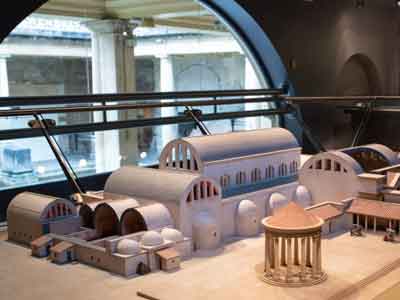
Model of the Roman Baths
Image © romanbaths.co.uk
- Importance: Houses artefacts discovered on-site, including coins, jewellery, and inscriptions that provide a window into the lives of those who used the baths.
- Visitor Experience: Interactive displays and exhibits help visitors understand the life and times of Roman Bath. Notable artefacts include the Gorgon’s Head, Roman curse tablets, and a vast collection of Roman coins.
Guided Tours and Tours from London
Types of Tours Available
There are various tour options to enhance your visit to the Roman Baths.
- Standard Guided Tours: These tours are led by knowledgeable guides who provide detailed insights into the history and significance of the Roman Baths.
- Audio Guides: Available in multiple languages, these guides allow visitors to explore at their own pace while learning about the site’s history and key features.
- Specialty Tours: Including evening torchlit tours, which offer a unique and atmospheric way to experience the baths after dark.
- Tours from London: Several tour operators offer day trips from London to Bath, including transportation and guided tours of the Roman Baths. These tours provide a convenient and comprehensive way to visit Bath without the hassle of planning the trip yourself.
Booking Tours
Booking your tour in advance can ensure availability and sometimes offer cost savings.
- How to Book in Advance: Tours can be booked online through the official Roman Baths website or via various travel agencies. Advance booking is highly recommended, especially for specialty tours.
- On-the-Spot Bookings: These can be made at the entrance, though availability may be limited during peak times.
Tours from London and Airports
Booking a tour from London or directly from major airports can save time and simplify travel logistics. Check more about Bath tours including walking tours and more from our Bath tours page
- Introduction to Convenience: Organised tours from London and nearby airports offer a hassle-free way to visit the Roman Baths. These tours typically include round-trip transportation and a guided tour of the site.
- Major Tour Providers: Many reputable tour operators offer day trips from London, often including transportation and guided tours of the Roman Baths.
These tours can be a convenient option for those who prefer not to navigate public transportation or drive.
- Group coach tour
- Duration 11h 30min approx
- Tour Guide
- Adult from £95
- Group coach tour
- Duration 11h approx
- Tour Guide
- Adult from £99
- Group coach tour
- Duration 12h 30min approx
- Tour Guide
- Adult from £132
- Group coach tour
- Duration 12h approx
- Tour Guide
- Adult from £131
- Group coach tour
- Duration 10h 30min approx
- Tour Guide
- Adult from £153
- Group coach tour
- Duration 11h approx
- Tour Guide
- Adult from £179
- Small group tour
- Duration 11h approx
- Tour Guide
- Adult from £174
Dining and Refreshments
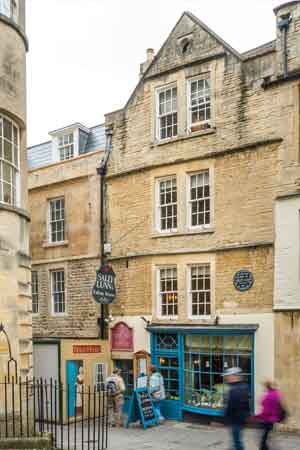
Image © Sally Lunn’s
On-site Cafes and Restaurants
Visitors to the Roman Baths can enjoy a variety of dining options without leaving the site. The Pump Room Restaurant offers an elegant setting for a meal or afternoon tea, with views of the historic baths.
- The Roman Baths Kitchen, located just across the street, provides a more casual dining experience with a range of British classics.
Nearby Dining Options
Bath city centre is home to numerous cafes, restaurants, and pubs. Whether you are looking for a quick snack or a full meal, you will find something to suit your taste and budget.
Popular options include traditional British fare, international cuisine, and charming tea rooms. Some favourite places include:
- Sally Lunn’s Historic Eating House
- The Ivy Bath Brasserie
- The Pump Room Restaurant.
Accommodation Options in Bath
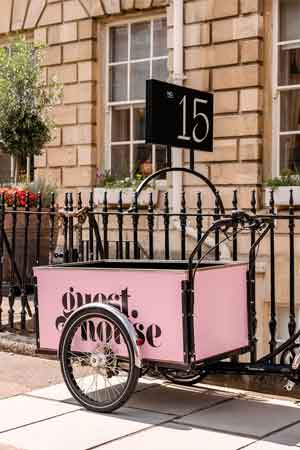
Image © Guesthouse Hotels
Hotels
Bath offers a range of hotels, from luxury to budget-friendly options. Popular choices include The Gainsborough Bath Spa, The Royal Crescent Hotel, and Abbey Hotel Bath.
Bed and Breakfasts
For a more personal touch, consider staying at a charming bed and breakfast. Many B&Bs are located in historic buildings and offer a cosy and welcoming atmosphere.
Budget-friendly Options
Hostels and budget hotels provide affordable accommodation for travellers. The YHA Bath and Premier Inn Bath City Centre are good options for those looking to save money.
AirBNB
In addition to traditional accommodations, Bath also has a variety of Airbnb options, ranging from entire homes to private rooms, catering to different preferences and budgets.
History of the Roman Baths
Origins and Construction
The Roman Baths were built around 70 AD by the Romans over the site of a natural hot spring. The complex included a temple dedicated to Sulis Minerva and various bathing facilities.
Evolution Through the Ages
Over the centuries, the Roman Baths have undergone numerous changes and restorations. After falling into disrepair, they were rediscovered and excavated in the 18th century. Today, they are a well-preserved historic site and a major tourist attraction.
Architectural Significance
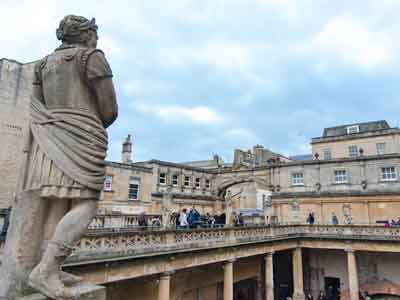
Key Structures and Design Elements of the Roman Baths
The Roman Baths feature impressive architectural elements, including the Great Bath, the temple courtyard, and the hypocaust heating system. The design reflects the Romans’ engineering skills and their appreciation for symmetry and grandeur.
Preservation Efforts
Ongoing archaeological and conservation work ensures that the Roman Baths remain preserved for future generations. Efforts include maintaining the structural integrity of the site and protecting the artefacts displayed in the museum.
Interesting Facts About the Roman Baths
Role in Roman Society
The Roman Baths were a central part of Roman life, serving as a place for relaxation, socialising, and conducting business. The baths were also a site for religious worship, dedicated to the goddess Sulis Minerva.
Heating System
The Roman Baths featured an advanced heating system known as the hypocaust, an early form of underfloor heating. Hot air from a furnace circulated beneath the floors and through the walls, keeping the bathhouses warm.
Famous Visitors
Throughout history, the Roman Baths have attracted numerous famous visitors, including Queen Anne, who visited in the early 18th century, and Jane Austen, who lived in Bath and mentioned the baths in her novels.
Practical Information and Insider Tips for Travellers
Best Times to Visit the Roman Baths
Timing your visit can make a significant difference in your experience.
- Avoiding Crowds: Early mornings or late afternoons are typically less crowded, providing a more relaxed experience. Weekdays are generally quieter than weekends.
- Seasonal Considerations: Visiting during off-peak seasons like late autumn or early spring can offer a quieter experience. The summer months and school holidays tend to be busier.
What to Bring
Packing the right items can enhance your visit.
- Recommended Attire: Comfortable walking shoes are essential as there is a fair amount of walking involved. Dress in layers to adjust to varying indoor and outdoor temperatures.
- Essential Items: Bring a camera to capture the beautiful architecture and historic artefacts. A water bottle and a small snack can be handy, especially if you plan to spend a long time exploring.
- Swimming Suits: While swimming is not allowed in the ancient Roman Baths, you can enjoy modern thermal waters at the nearby Thermae Bath Spa or at your hotel’s pool and spa facilities.
Insider Tips and Recommendations About the Roman Baths
Best Photo Spots in and around the Roman Baths
For the best photos, head to the terrace overlooking the Great Bath or capture the intricate details of the temple pediment. The evening torchlit tours also provide a unique and atmospheric backdrop for photography.
Hidden Gems Within the Roman Baths
Don’t miss the lesser-known artefacts, such as the Roman curse tablets and the reconstructed temple pediment. These items offer fascinating insights into the daily lives and beliefs of the Romans who visited the baths.
Insider Tips for a Great Visit
- Arrive early to avoid crowds.
- Take advantage of the audio guides for a more in-depth understanding of the site.
- Spend time in the museum to appreciate the artefacts and interactive displays.
Safety and Etiquette
- Respecting the Site: Do not touch the artefacts or disturb the historical structures.
- Covid-19 Guidelines: Follow any current health and safety guidelines, including wearing masks and maintaining social distancing where required.
Exploring Bath Beyond the Roman Baths: Nearby Attractions
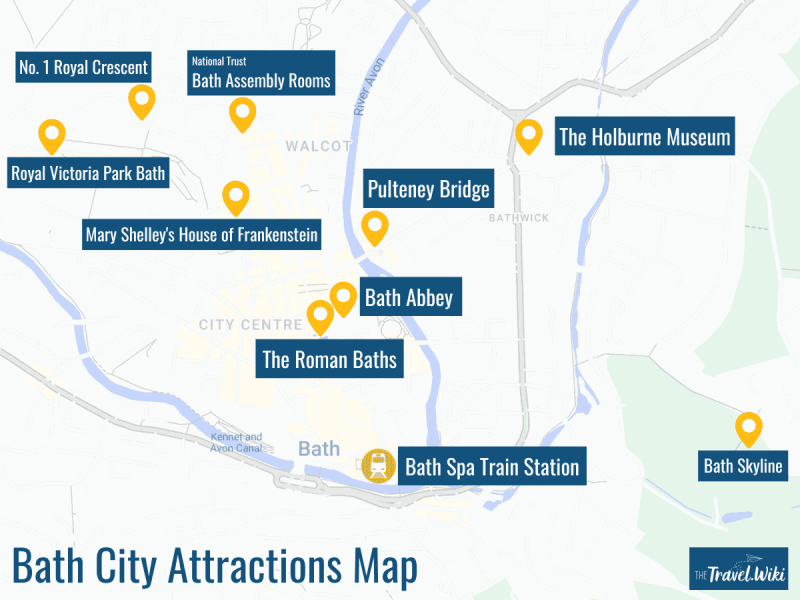
Other Historical Sites and Attractions
A selection of highlights from Bath city can be found below. For more ideas on what to do in Bath, be sure to check out our detailed “20 Top Thing to Do in Bath” page.
Bath Abbey
A stunning example of Gothic architecture, Bath Abbey is a must-visit site. The abbey offers beautiful stained glass windows and panoramic views of the city from its tower.
The Royal Crescent
This iconic Georgian architectural masterpiece is one of Bath’s most photographed landmarks. Visitors can explore No. 1 Royal Crescent, a museum that recreates life in the 18th century.
Pulteney Bridge
One of the most beautiful bridges in the world, Pulteney Bridge is lined with shops and offers picturesque views of the River Avon.
Suggested Itineraries for Bath
One-day Visit
Start with a visit to the Roman Baths, followed by a tour of Bath Abbey. Enjoy lunch at a local cafe, then stroll through the Royal Crescent and finish the day with a walk along Pulteney Bridge.
Weekend Stay
Extend your visit to include a session at the Thermae Bath Spa, a visit to No. 1 Royal Crescent, and exploring the Jane Austen Centre. Enjoy dining at one of Bath’s many excellent restaurants.
Frequently Asked Questions (FAQ) for Visiting Roman Baths
How long does it take to visit the Roman Baths?
A typical visit to the Roman Baths takes about 1.5 to 2 hours.
Are the Roman Baths suitable for children?
Yes, the Roman Baths are suitable for children. Interactive exhibits and family-friendly audio guides are available.
Is photography allowed?
Yes, photography is allowed, but flash photography is not permitted in some areas.
Are there guided tours available at the Roman Baths?
Yes, guided tours are available and provide detailed insights into the history and significance of the Roman Baths.
Can I swim in the Roman Baths?
No, swimming is not allowed in the ancient Roman Baths. However, visitors can enjoy modern thermal waters at the nearby Thermae Bath Spa.

